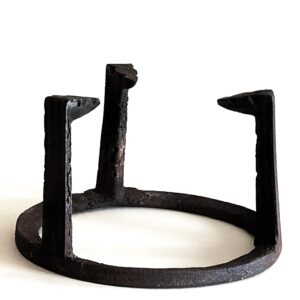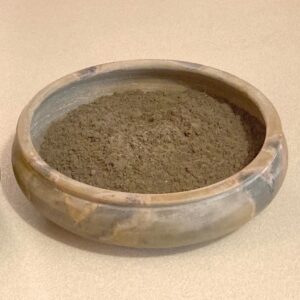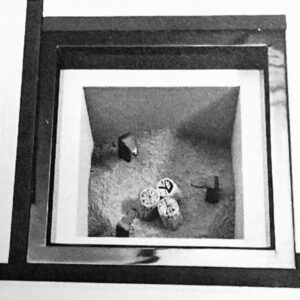Ro and Hai: Hearth and Ash

The ro, 炉, (sunken) hearth, is set in the floor of a room designated for the presentation of Cha-no-yu, 茶の湯, Tea’s Hot water. According to Sen no Rikyū, 千利休, Thousand Rich-quit, the opening of the ro is 14 sun kane-jaku, 寸曲尺, square. The housing of the ro is the ro-dan, 炉壇, hearth-foundation, and the opening of the rodan is one shaku kane-jaku square. In several circumstances, measurements for the ro are made with kujira-jaku, 鯨尺, whale-measure, so that the opening of the rodan may be determined as 8 sun kujira-jaku square.
The ro, like the portable fu-ro, 風炉, wind-hearth, is filled with hai, 灰, (wood) ash, which is usually made from burning kunugi, 樟, a kind of oak. Ash for the hearth, ro-bai, 炉灰, hearth-ash, is similar to that for furo, but is made damp before sprinkling it over the ash bed, to keep down flying ash. It is called shimeshi-bai, 湿し灰, damp-ash. The damp ash is to aid in protection from fire, and water is a prime example of the aspect of Yin, In, 陰, Negative, receptive, complementary to the fire being a prime example of the aspect of Yang, Yō, 陽, Positive, penetrative.

The kama, 釜, kettle, for the ro originated from the large kama used with a large furo in temple Tea presentations. In general, the kama is supported in the ro on a trivet-like iron go-toku, 五德, five-virtues. The gotoku is a wa, 輪, ring, with three ashi, 足, legs, ending in triangular tsume, 爪, talons. The ring is buried in the ash bed, so that only the legs and the talons are visible.
There are essentially two positions for the gotoku. The most formal arrangement has a tsume pointed toward the host, tei-shu, 亭主, house-master, with two tsume at the front. The other more common placement has the tsume on the right side pointing directly left, toward the place where a lamp, tan-kei, 短檠, short-frame, can be displayed. this tsume is called the kei-zume, 檠爪, rack-talon.
The Kanji for kei, 檠, is composed of kei, 敬, respect, and moku, 木, tree. Not by coincidence in the yo-jō-han, 四畳半, four-mat-half, the tankei is placed to the left of the ro, and very close to the toko-bashira, 床柱, floor-post, which is a trunk of a tree. Perhaps, the keizume is pointed toward the tokobashira, because the tankei is used in the Tearoom at night. The tokobashira is the ‘respected tree’.
The three ashi, 足, leg, foot, may be associated with the san-gu-soku, 三具足, three-utensil-leg, the set of utensils displayed on the Buddhist altar. The sangusoku provide the three essential offerings of kō-ge-tō, 香華灯, incense-flower-lamp; incense is presented in a kō-ro, 香炉, incense-hearth, the flower in a hana-tate, 花立, flower-stand, and candlelight in a shoku-dai, 燭台, lamp-support.
The disintegrated appearance of the iron gotoku is called mushi-kui, 虫食い, worm-eaten. In Taoism, there are the san-shi, 三尸, three-corpses, also san-chū, 三虫, 三蟲, three worms, that inhabit the human body from birth, and bring disease and misfortune. The corpses and worms are located in the three elixir fields, san-tan-den, 三丹田, three-red-fields, the three energy centers in the head, chest, and abdomen. It is curious to note that the original Kanji for chū, mushi, 蟲, is composed of three instances of the kanji, 虫.
The three corpses/worms are:
Jō-shi, 上尸, upper-corpse, which lives in the brain, and is depicted as a Taoist sage who holds a scroll with recorded faults, and causes illness above the neck, and over-eating.
Chū-shi, 中尸, middle-corpse, lives in the gut, is depicted as a kind of lion, and that holds a record scroll, causes illness in the inner organs, and the love of money.
Ge-shi, 下尸, lower-corpse, lives in the feet, causes illness from the waist down, is depicted with an ox head and one human leg, holds a record scroll in its mouth.
It is believed that the three worms eat only grains, so it is advised that a person should avoid eating grains in their diet, which starves the invaders. This is a great challenge for Asian people, as rice is the staple of their diet.
From ancient times in Asia, the calendar, years, days, hours etc. are identified with various systems. Perhaps the most familiar system, even in the West, are the 12 animal signs in the Asian zodiac, Jū-ni-shi, 十二支, Ten-two-branches. The Kanji for Asian zodiac animals are different for the actual animals, dō–butsu, 動物, move-thing, mythical or not.
Jūnishi: 十二支
Ne, 子, Rat
Ushi, 丑, Ox
Tora, 寅, Tiger
U, 卯, Hare
Tatsu, 辰, Dragon
Mi, 巳, Snake
Uma, 午, Horse
Hitsuji, 未, Ram
Saru, 申, Monkey
Tori, 酉, Cock
Inu, 戌, Dog
I, 亥, Wild Boar
Dōbutsu: 動物
Nezumi, 鼠, rat
Ushi, 牛, water buffalo
Tora, 虎, tiger
Usagi, 兎, hare
Ryū, 龍, dragon
Hebi, 蛇, snake
Uma, 馬, horse
Hitsuji, 羊, mountain goat
Saru, 猿, monkey
Tori, 鳥, cock
Inu, 犬, dog
Inoshishi, 猪, wild boar
The most familiar and pervasive are Yin and Yang, In and Yō, 陰 and陽, Negative and Positive, receptive and penetrative. Any thing is In; a way to remember is ‘In is in thing’. Yō is no thing, such as thought, emotion. In the In realms, everything manifests In and Yō in varying degrees, for example water is In, fire is Yō; female and male. These ideas are the basis of the I Ching, Eki-kyō, 易経, Change-sutra.
Another essential aspect of the Ekikyō is dividing thing into five physical elements, go-gyō, 五行, five-transitions, and five principles go-rin, 五輪, five-rings.
Go-gyō: 五行
Moku, 木, Wood
Kon, 金, Metal
Ka, 火, Fire
Sui, 水, Water
Do, 土, Earth
Go-rin: 五輪
Kū, 空, Void
Fū, 風, Wind
Ka, 火, Fire
Sui, 水, Water
Chi, 地, Earth
The Go-gyō, 五行, five physical elements are divided into aspects of In and Yō, in a system called E-To, 干支, Ji–kkan, 十干, ten-intercede, and jū-ni-shi, 十二支, ten-two-branches, Intercede-branch. They are also identified as older and younger. The 10 In and Yō Eto elements are called Ju-kkan, 十干, Ten-dry. They are:
Kinoe, 甲, Wood’s elder, also read kō, kan, meaning shell, armor.
Kinoto, 乙, Wood’s younger, also read itsu, otsu, meaning second.
Hinoe, 丙, Fire’s elder, also read hei, meaning third.
Hinoto, 丁, Fire’s younger, also read chō, etc., meaning counter.
Tsuchinoe, 戊, Earth’s elder, also read bo, bō, meaning fifth.
Tsuchinoto, 己, Earth’s younger, also read ko, ki, meaning self.
Kanoe, 庚, Metal’s elder, also read kō, meaning seventh.
Kanoto, 辛, Metal’s younger, also read shin, meaning hot, spicy, etc.
Mizunoe, 壬, Water’s elder, also read jin, mi, jin, meaning ninth.
Mizunoto, 癸, Water’s younger, also read ki, meaning tenth.
In the refinement of Asian thought, ten In and Yō physical elements are combined with the twelve zodiac signs. For example, the first of the Eto In Yō aspects of the five elements is, Kinoe, 甲, and the first Jūnishi, zodiac animal signs, Ne, 子, combine to form Kinoe Ne, 甲子, which is read Kanshi, and Kōshi.
In the Taoist tradition of Kō-Shin-machi, 庚申待, Age (Kanoe, fire’s elder)-Monkey (Saru, have the honor)-wait, was adopted from China during the Heian period. It means staying awake on the eve of the 57th day of the sexagenary cycle, Kō-Shin, to prevent the three worms that were said to inhabit the human from leaving the body to report to Yama the King of Hell, the human being’s wrongdoings, and to shorten its life. There are rites to eliminate the three worms. Staying awake could evoke the Yo-banashi cha-ji, 夜咄 茶事, Night-talk Tea-matter.

The distressed treatment is on the two surfaces that are directed toward the center of the gotoku; the exterior surface is plain. Each of the three ashi is triangular, so that the total number of surfaces on the three ashi is nine. The three corpses are accompanied by nine worms: San-shi Kyū-chū, 三尸九蟲, Three-corpses Nine-worms. The concept of these entities is described in classical texts starting from the Han dynasty, and are detailed throughout numerous Taoist alchemical texts.
The Kanji, 尸, for three corpses, 三尸, resembles the legs and talons of the gotoku. Also, they appear to be separated from the ring hidden in the ash, and that they are worm-eaten. The nine sides of the gotoku ashi suggest the Taoist Nine Worms.
Worms do not eat metal. Metal comes from the earth, the ashes in the hearth represent Earth. According to Asian philosophy of the Five Element Law of Creation, Earth feeds Metal, Metal feeds Water, Water feeds Wood, Wood feeds Fire, and Fire feeds Earth.
World agricultural settings have found that earthworm burrows can improve water infiltration and soil aeration, and their excrement forms soil aggregates by combining minerals and organic matter. Earthworm activity can also relieve compaction and make nutrients available to plants.
Ash is identified as Earth, and the shimeshi bai may be regarded as having been processed by earthworms.

The average haiki fully contains approximately 3 1/3 cups of ash, or about shi-shaku, 四勺, four ‘measure’. There is a remote possibility that there is a related wordplay on shi-shaku, 師釈, master-explain, teacher, religious leader. The word shaku is in the Japanese name of Sha-ka Butsu, 釈迦仏, Explain-(sound) Buddha.
Portions of the Buddha’s ashes were buried in circular mounds of earth called stupa, Sanskrit ‘heap’. The earliest stupas, containing portions of the Buddha’s ashes, began to be associated with the body of the Buddha. Adding the Buddha’s ashes to the mound of dirt activated it with the energy of the Buddha himself.
Additional shimeshi-bai is held in a hai-ki, 灰器, ash-container, that is a wide shallow bowl with a smooth bottom, as it is placed over the edge of the ro-buchi, 炉縁, hearth-edge, when spooning ash from the bowl, and spreading in the ro.
When building the first charcoal fire, sho-zumi, 初炭, first-charcoal, using the hai-saji, 灰匙, ash-spoon, half of the shimeshi-bai is spread on the ash bed around the fire of the ro with five scoops of ash. Half of the ash remains in the haiki. This means that of the original four shaku of ash in the haiki, ni-shaku, 二勺, two-‘measures’, of shimeshi-bai is spread in the ro, and two shaku of ashes remain in the haiki.
The word nishaku maybe wordplay on ni-shaku, 二尺, two-spans. A Google search for ‘ni-shaku’, cited first ‘ni shaku go sun’, 二尺五寸, two-length ‘foot’ five-‘inch’, which is the length of a sword given to Hideyoshi. Five scoops of ash should equal two shaku, 勺, of shimeshi-bai.

Uroko, 鱗, scales: photo of scales of a koi, 鯉, carp. ‘Uroko’ refers to scale, and in Chanoyu, uroko implies dragon scales. The Japanese dragon has features taken from various animals, one of which is scales that are like scales of a koi, 鯉, carp. So, the uroko ash indicates that the furo may have something to do with dragons. The dragon is the symbol of Enlightenment in Buddhism. The dragon figures in the development of the Kundalini.
Spreading of shimeshi-bai is done in the presence of the guests. A parallel application is present in the furo with its uroko-bai, 鱗灰, scale-ash, however ash is laid on the ash bed before the arrival of the guests. Uroko-bai, 鱗灰, scale-ash, is made of furo ash made damp and laid on the ash bed is small spoonsful that resemble ‘dragon’ scales. Various schools of Tea have different versions of urokobai.
After his cremation in Kushinagara, the Buddha’s ashes were divided into eight portions and distributed to various clans and kings. It is thought that the origin of the name kushinagara was named for the abundance of the kusha grass growing in this region of India. Sanskrit kushi In Japanese is kusa, 草, grass.

Using naga hi-bashi, 長火箸, long fire-rods, the ash in the rodan is dragged up from the corners to the mid-point along the sides, creating four peaks, one along each side of the rodan. This creates eight angles and eight spans, each of the spans is 5 sun kujira-jaku. When added together, the sum is 10 sun kane-jaku, or one shaku kujira-jaku. Each rodan wall width of 8 sun kujira-jaku, compares to 10 sun kujira-jaku spans of the ash; 8:10. Shi-kaku, 四角, four-corner, form. The ro is square, shikaku.

Using a gotoku in both the furo and the ro is essential to basic symbolism, as it provides the san-kaku, 三角, three corner, form. The third basic shape of the circle, en, 円. With the furo, the furo is a circle, the nimonji hai is the shikaku, the gotoku is the san-kaku, 三角, three-corner.
The circle in conjunction with the ro may be the kama, or it may be the crest of the ash. Rikyū’s preferred kama is the Amida–dō, 阿弥陀堂, which is round. There are kama other than round. Before building the charcoal in the ro, shimeshi bai, 湿灰, damp-ash, is distributed over the entire surface of the ash bed.
During sumi de-mae, 炭手前, charcoal hand-fore, building the charcoal fire in the presence of the guests, shimeshi bai is spooned five times over the ash bed. This is done is prescribed form, although the exact location of each spoonful and the amount is not specified. Generally, the ash is sprinkled from and to each crest of ash. Typically, the track of the ash is a straight line, although diagrams issued by Urasenke indicate that the track of ash is in an outward curve. This implies that the finished pattern of the ash is a circle, not a square.
Both furo and ro can have two charcoal presentations; sho-zumi, 初炭, first-charcoal and go–zumi, 後炭, latter-charcoal.

Spreading shimeshi-bai, 湿し灰, damp-ash, in the ro is done with five spoonsful of ash. They are laid where the damp ash bed has dried close to the three pieces of burning charcoal, shi-tabi, 下火, down-fire. From the perception of the teishu, the near side of the ro is identified with the south, and the far side is identified with the north. The sequence of spooning the ash is one spoonful from north to west, then another spoonful from west to south, then one from north to east, one from east to south, and a final spoonful from south to east.
In the pattern of spreading the shimeshi-bai in the most formal style, eleven spoonsful are spread on the ash bed. The intention is to approximate covering the entire ash bed surface with damp ash. There are eight spoonsful from peak to valley, valley to peak, and so forth on all four sides of the rodan. The final three spoonsful are spread close to the shita-bi from north to southwest, north to southeast, and last from west to east.

Incense burned in the fire of the ro is neri-kō, 練香, knead-incense, and it is held temporarily in a kō-gō, 香合, incense-gather. Nerikō is a blend of ground aromatics and charcoal dust held together with a kind of honey, and is wet to the touch. The piece of nerikō is shaped into a shi-men-tai, 四面体, four-face-object. In Buddhism, one of the most important deities is Dai-nichi Nyo-rai, Sanskrit, Maha Vairocana, 大日如来, Great-Sun Like-become, is the universe made manifest, and has four faces indicating his omnipresence.
Regardless of the form, the kō-gō, represents the hō-jū, 宝珠, treasure-jewel. The hōju is often held in the hands of Buddhist and other deities. The hōju is also called the nyo-i-rin, 如意輪, Like-mind-ring, and is associated especially with one of Kannon’s 33 manifestations, Nyo-i-rin Kan-non, 如意輪 観音, Like-mind-ring See-sound, who grants wishes.
The importance of numbers is vast, and many numbers have multiple connections. The number eleven, 11, jū-ichi, 十一, has several associations with various groups, One aspect of 11 is 10 identified collectively as a single thing, one. The number 11 is associated with one of 33 manifestations of Kannon; Jū-ichi-men Kan-non, 十一面觀音, Ten-one-face See-sound. Images depict the Buddhist deity in human form with a crown of ten different faces or heads. Perhaps the 11 faces of Kannon may be identified with the 11 spoonsful of ash spread on the ro ash bed.
According to Asian geomancy, Juichimen Kannon protects the north direction, and in the yojōhan chashitsu, Kannon may be identified with the toko-bashira, 床柱, floor-post. This wooden post is in the middle of the north wall of the yojōhan. The general area of Kannon’s influence is where water-filled flower containers are displayed in the tokonoma. Kannon is closely associated with water, and at times is depicted holding a lotus flower, a willow branch, etc.
The 11-headed Kannon is also represented with thousands of arms, which rise like the outspread tail of a peacock around the back of the figure. Kannon, in Sanskrit is Avalokiteshvara, is depicted riding on a peacock. When building the charcoal fire, the hearth is swept with a ha-bōki, 羽箒, feather-brush, which is made of various kinds of feathers, often from birds of prey. A large peacock feather would be ill-suited as a habōki.
Throughout most cultures, numbers are highly symbolic, and in Japan this is widely prevalent. The number 11, in Japanese, jū-ichi, 十一, ten-one, can refer to one of the thirty-three manifestations of Kannon, Jū-ichi-men Kan-non Bo-satsu, 十一面観音菩薩, Ten-one-face See-sound Grass-buddha. When researching the internet in Japanese for, 十一, and ‘Buddhism’, Bu-kkyō, 仏教, Buddha-faith, the first and many subsequent listings refer to ‘Jūichimen Kannon’


